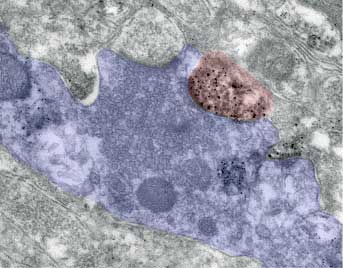| RIKEN Center for Developmental Biology (CDB) 2-2-3 Minatojima minamimachi, Chuo-ku, Kobe 650-0047, Japan |
Now, in an article published in The Journal of Neuroscience, Sachihiro Suzuki of the Laboratory for Cell Adhesion and Tissue Patterning (Masatoshi Takeichi; Group Director) and his collaborators have demonstrated that one of classic cadherins, cadherin-8 (cad8), is essential for the synaptic transmission of cold sensation, as evidenced by the the finding that cad8 knockout mice (cad8-/-) are insensitive to cold stimuli.
Suzuki first identified the types of cells that express cad8 as sensory neurons in the DRG, and examined the relationship between cad8-expressing sensory neurons and cad8-expressing DH neurons. They found a significant overlap between cad8 sensory neurons and those expressing TRPM8, a cold and menthol receptor in DRG: most of the cad8-expressing neurons also expressed TRPM8, and vice versa. Electron microscopy showed that synapses were formed between sensory neurons and DH neurons expressing cad8. Next they examined effects of cad8 genetic ablation on their connection and found that even in the absence of cad8, synapses still formed. The group also performed electrophysiological analyses to examine the effects of loss of cad8 on functions of the synapses. Although cad8-expressing DH neurons received inputs from menthol activated fibers (that is TRPM8-expressing sensory neurons in the cad8+/- population), originally cad8-expressing DH neurons in cad8-/- did not receive functional input from TRPM8-expressing sensory neurons. Based on these results, the authors concluded that cad8 is not essential for formation of synapses between cad8-expressing sensory neurons and cad8-expressing DH neurons, but is somehow involved in the physiological function of the synapses between them.
Suzuki notes that, “cad8 may facilitate synaptic vesicle release at the axon terminals of TRPM8-expressing sensory neurons. In the future, we aim to clarify how cad8 regulates activities of the synapses between TRPM8-expressing neurons and their target neurons in the spinal cord in more detail.” |
|||||||
|
|||||||
 |
| Copyright (C) CENTER FOR DEVELOPMENTAL BIOLOGY All rights reserved. |
